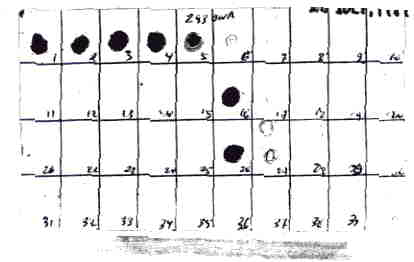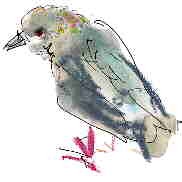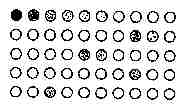|
Norman
Allan
|
||||
|
the Southern blot
DNA ultradilution phenomenon |
|
|
|
|
||
 |
Wikisay: "A Southern blot is a method used in molecular biology for detection of a specific DNA sequence in DNA samples." Note: the "probe" is usually labeled with radioactive phosphorous 32: however, Eweida and all were working with an alternative labeling technique using biotinylated probes |
 |
I described this work is detailed in "Beyond Substance" thus... "Professor AbouHaidar was working on a viral assay. You'd take a plant from a field - he was working with potatoes - grind it up, run it through the Professor's assay, and it would tell you whether there was any of a particular virus present in those potatoes. It works like this: you take a virus, which in this case was a DNA virus, and you "digest it", splitting each bit of viral DNA into two single complementary strands. Then you divide this digest into two parts. At this point the two parts are (statistically) identical. Take one half of this now single stranded DNA and call it the "target". Take the other half and call it the "probe". The target is spotted out on a filter paper - that is to say, you put a drop of it on a microfilter to make a spot. Then you dilute what's left one part in ten, and put a drop of the dilute solution at a second spot. Then dilute again one part in ten, and spot it out again. Keep diluting and spotting out the successive dilutions. This is to test how sensitive the assay is. After all, we may be looking for a little bit of virus in a whole field of potatoes. We need a sensitive assay. Having spotted out all these successive dilutions, we take the filter paper and bake it at 80 degrees centigrade. After baking, the target won't wash off. Next let us consider the probe. The probe, remember, in this explanation, the probe is made up of the same single stranded viral DNA fragments. These we're going to label so we can see them. We mix them with avidin-biotin. The avidin binds to the DNA, and the biotin will bind to a stain, so we'll get a dark spot where our DNA-avidin-biotin binds the stain. Now we take our probe and wash it over the targeted filter paper. Where the DNA in the probe finds its complementary strand in the target it binds to it. Next we wash the probe and target, and only where the probe has bound to its complementary strand will there be any of the probe be left. The rest is washed away. Then we 'develop' the probe/target filterpaper with our stain. Only where the labeled probe has bound to the target will we see any stain. In the test as set it up, the stain gets lighter and lighter with each dilution. It's dark, almost black, in the first couple of dilutions, but fades out of sight at about the seventh dilution.
That's the assay AbouHaidar was refining. (Actually, it's Dr. Southern's dot-blot test, so it's called "Southern blot", though Dr. Western's "Western dot-blot" predates it and is more widely used.). Mohammed Eweida was a postdoc working in Prof. AbouHaidar's lab with this Southern blot assay. Mohammed Ewieda wasn't very happy about his situation. I don't know why, but he was out of there: he was off to the Karolinska Institute in Stockholm in the summer: and so, perhaps to kill time, he spotted out the dilutions eighteen times, even though the staining was lost to sight at the seventh, and... and he got a dark spot at the eighteenth dilution!
"Look at that," said Dr. Eweida to Michael Dobbs, a postgraduate student working in the lab. Some months before Mike Dobbs had been to Jacque Benveniste's lecture on ultradilution. (In Homeopathy substances are diluted beyond the infinitesimal till there's no substance left, which is what is meant by "ultradilution".) So, when Mohammed showed Michael his anomalous result with an unexpected spot at the eighteenth dilution Michael thought, incredulously, "ultradilution". "Eh, Mohammed," he said. "Do that again." Dr. Eweida repeated the viral assay, this time taking it out to the fiftieth decimal (one in ten) dilution. (That's 10-50 where ten to the minus 30 is like a drop in the ocean, and 10-37 is like a drop in a million oceans. At 10-26 we pass "Avagadro's number [which relates to the number of molecules in a "gram molecule"] and would no longer expect to find a single molecule in a gram.) Again there was a dark spot that shouldn't be there at the eighteenth dilution,
and now there were also stained spots at the 19th dilution, and the 25th and 26th, and the 38th, and 43rd dilution, but not at the dilutions in between. At the 25th and 26th dilutions there is certainly no substance left in the solution. We have passed Avagadro's number. There is no DNA left in the target.(footnote) And yet the undiluted complementary strands in the probe (labeled with avidin-biotin) binds to the target! They can not be binding to a substance, not to molecular DNA. They may be binding to a signal, an electrical signal imprinted into the nitrocellulose. They are binding to something!"
and to see the above excerpt
in full context go to "Beyond
Substance" |
||
|
And, I have just discovered
that Southern blot biotin "kits" are available... |
||
|
|
||
 |
 |
|
|
|
||
|
|
 |

